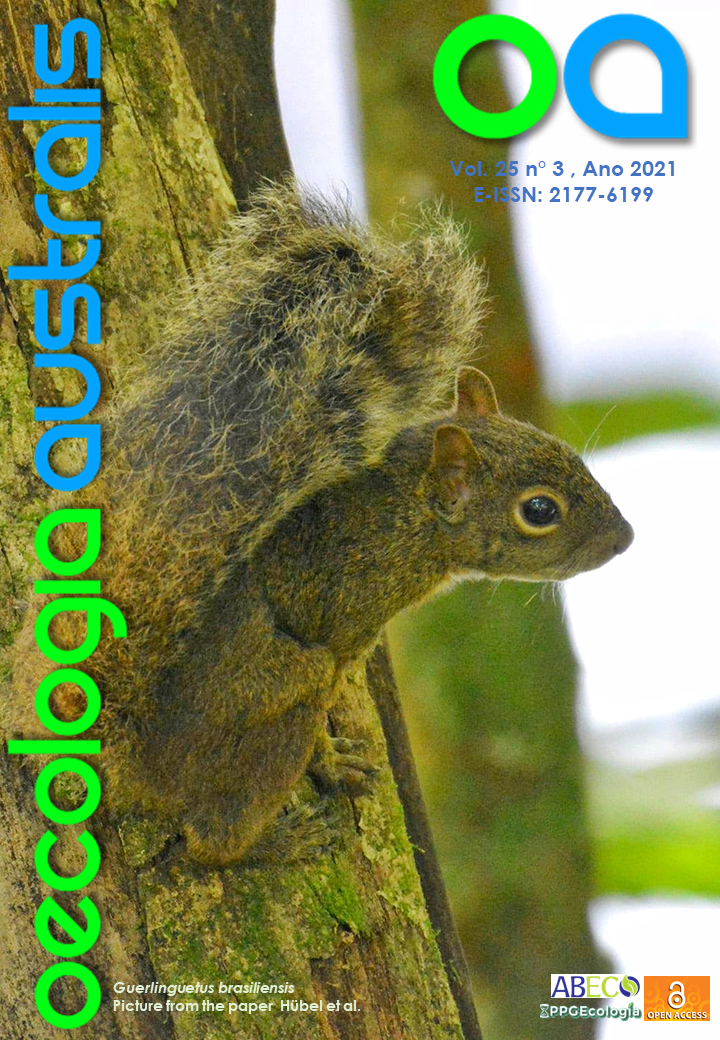FIRST OCCURRENCE AND SEXUAL BEHAVIOR OF CRYPTONTSIRA PARVA (MUESEBECK, 1941) (HYMENOPTERA, BRACONIDAE) PARASITIZING LYCTUS BRUNNEUS (STEPHENS, 1830) (COLEOPTERA, BOSTRICHIDAE) IN SOUTH AMERICA
DOI:
https://doi.org/10.4257/oeco.2021.2503.12Keywords:
biological control, borer, parasitoid–host relationship, reproductive aspects, waspAbstract
The current study describes the first record in South America and the sexual behavior of Cryptontsira parva (Muesebeck, 1941) (Hymenoptera, Braconidae, Doryctinae) parasitizing Lyctus brunneus (Stephens, 1830) (Coleoptera, Bostrichidae, Lyctinae). We also include a brief report of the ethological reproductive aspects the C. parva under laboratory conditions by providing information to support research on biological control of L. brunneus.Downloads
References
Avila, G. A., Withers, T. M., & Holwell, G. I. 2017. Courtship and mating behaviour in the parasitoid wasp Cotesia urabae (Hymenoptera: Braconidae): mate location and the influence of competition and body size on male mating success. Bulletin of Entomological Research, 107, 439–447. DOI: 10.1017/S0007485316001127
Beesley, J. 1956. Common borers in building timbers. Part II. The Lyctus (or powder post) borer. CSIRO Forest Products Newsletter, 225.
Belokobylskij, S. A. 2008. A new genus of the tribe Doryctini (Hymenoptera, Braconidae, Doryctinae). Zoosystematica Rossica, 17 (1), 123–130.
Benelli, G., Bonsignori, G., Stefanini, C., & Canale A. 2012. Courtship and mating behaviour in the fruit fly parasitoid Psyttalia concolor (Szépligeti) (Hymenoptera: Braconidae): the role of wing fanning. Journal of Pesticide Science, 85, 55–63.
Bredlau, J. P., Mohajer, Y. J., Cameron, T. M., Kester, K. M., & Fine, M. L. 2013. Characterization and generation of male courtship song in Cotesia congregata (Hymenoptera: Braconidae). PloS ONE, 8, e62051.
Canele, A., Benelli, G., Lanzo, F., Giannotti, P., Mazzoni, V., & Lucchi, A. 2013. The courtship song of fanning males in the fruit ply parasitoid Psyttalia concolor (Szépligeti) (Hymenoptera: Braconidae Bulletin of Entomological Research, 103, 303–309.
Field, S., & Keller, M. 1993. Courtship and intersexual signaling in the parasitic wasp Cotesia rubecula (Hymenoptera: Braconidae). Journal of Insect Behavior, 6, 737–750.
Freitas, M. D. R. T., Mendonça, A. L., Nascimento, R. R. D., & Sant’ana, A. E. G. 2004. Behavioural evidence for a female sex pheromone in Cotesia flavipes (Hymenoptera: Braconidae). Physiological Entomology, 29, 183–187.
Ide, T., Kanzaki, N., Ohmura, W., & Okabe, K. 2016. Molecular identification of an invasive wood-boring insect Lyctus brunneus (Coleoptera: Bostrichidae: Lyctinae) using frass by loop-mediated isothermal amplification and nested PCR assays. Journal of Economic Entomology, 109 (3), 1410–1414. DOI: 10.1093/jee/tow030
Joyce, A. L., Hunt, R. E., Bernal, J. S., & Vinson, S. B. 2008. Substrate influences mating success and transmission of courtship vibrations for the parasitoid Cotesia marginiventris. Entomologia Experimentalis et Applicata, 127, 39–47.
Lewis, C. N., & Whitfield, J. B. 1999. Braconid wasp (Hymenoptera: Braconidae) diversity in forest plots under different silvicultural methods. Environmental Entomology, 28, 986–997.
Liu, L.-Y., & Geis, K. U. 2019. A synopsis of the Lyctine beetles of Eurasia with a key to the species (Insecta: Coleoptera: Bostrichidae: Lyctinae). Journal of Insect Biodiversity, 2, 34–56. DOI: 10.12976/jib/2019.09.2.1
Marsh, P. M. 1997. Subfamily Doryctinae. In: Wharton, R. A., Marsh, P. M. & Sharkey, M. J. (Eds), Manual of the new world genera of the family Braconidae (Hymenoptera): subfamily Doryctinae. pp. 206–233. Washington: The International Society of Hymenopterists.
Matthews, R. W. 1974. Biology of Braconidae. Annual Review of Entomology, 19, 15–32.
McClure, M., Whistlecraft, J., & McNeil, J. N. 2007. Courtship behaviour in relation to the female sex pheromone in the parasitoid Aphidius ervi (Hymenoptera: Braconidae). Journal of Chemical Ecology, 33, 1946–1959. DOI: 10.1007/s10886-007-9355-5
Muesebeck, C. F. W. 1941. Two new reared species of Doryctes (Hymenoptera: Braconidae). Proceedings of the Entomological Society of Washington, 43, 149–152.
Peters, B. C., Creffield, J. W., & Eldridge, R. H. 2002. Lyctine (Coleoptera: Bostrichidae) pests of timber in Australia: A literature review and susceptibility testing protocol. Australian Forestry, 65 (2), 107–119.
Querner, P. 2015. Insect pests and integrated pest management in museums, libraries and historic buildings. Insects, 6 (2), 595–607.
Rezende, M. A. A., Della Lucia, T. M. C., Cruz, I., & Vilela, E. F. 1995. Comportamento de corte, acasalamento e postura de Chelonus insuiaris (Hymenoptera: Braconidae) em ovos de Spodoptera frugiperda. Revista Brasileira de Biologia, 55 (4), 555–558.
Shaw, M. R., & Huddleston, T. 1991. Classification and biology of braconid wasps. In: Dolling, W. R. & Askew, R. R. (Eds.), Handbooks for the identification of british insects. pp. 1–126. London: Royal Entomological Society of London.
Tagawa, J., & Hidaka, T. 1982. Mating Behaviour of the Braconid Wasp, Apanteles glomeratus L. (Hymenoptera: Braconidae): Mating sequence and the factor for correct orientation of male to female. Applied Entomology and Zoology, 17 (1), 32–39.
Unger, A., Schniewind, A., & Unger, W. 2001. Conservation of wood artifacts. 1nd ed. A Handbook: Springe: p. 600
Vinson, S. B. 1972. Courtship behavior and evidence of a sex pheromone in the parasitoid Campoletis sonorensis (Hymenoptera: Ichneumonidae). Environmental Entomology, 1, 409–414.
Yalçin, M., Yüksel, B., Akçay, Ç., Akay, E., & Akbulut, S. 2017. Monolexis fuscicornis’ in (Hymenoptera) parkelerde zarar yapan Lyctus brunneus (Coleoptera) böceğinin parazitoiti olarak değerlendirilmesi. Journal of Advanced Technology Sciences, 6, 1053–1059.
Xu, H., Veyrat, N., Degen, T., & Turlings, T. C. J. 2014. Exceptional use of sex pheromones by parasitoids of the genus Cotesia: males are strongly attracted to virgin females, but are no longer attracted to or even repelled by mated females. Insects, 5, 499–512.


